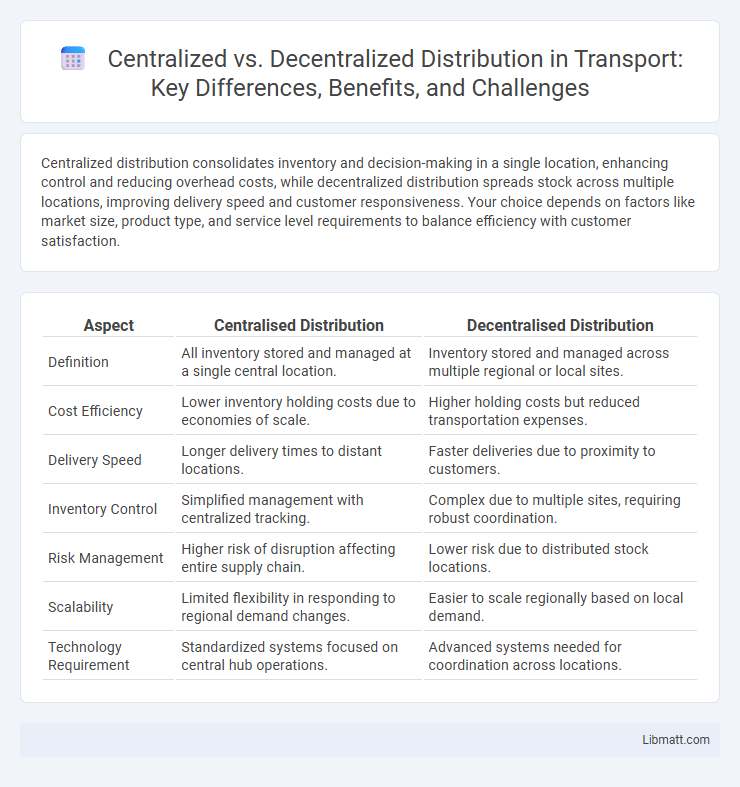Centralized distribution consolidates inventory and decision-making in a single location, enhancing control and reducing overhead costs, while decentralized distribution spreads stock across multiple locations, improving delivery speed and customer responsiveness. Your choice depends on factors like market size, product type, and service level requirements to balance efficiency with customer satisfaction.
Table of Comparison
| Aspect | Centralised Distribution | Decentralised Distribution |
|---|---|---|
| Definition | All inventory stored and managed at a single central location. | Inventory stored and managed across multiple regional or local sites. |
| Cost Efficiency | Lower inventory holding costs due to economies of scale. | Higher holding costs but reduced transportation expenses. |
| Delivery Speed | Longer delivery times to distant locations. | Faster deliveries due to proximity to customers. |
| Inventory Control | Simplified management with centralized tracking. | Complex due to multiple sites, requiring robust coordination. |
| Risk Management | Higher risk of disruption affecting entire supply chain. | Lower risk due to distributed stock locations. |
| Scalability | Limited flexibility in responding to regional demand changes. | Easier to scale regionally based on local demand. |
| Technology Requirement | Standardized systems focused on central hub operations. | Advanced systems needed for coordination across locations. |
Introduction to Distribution Systems
Centralized distribution systems concentrate inventory in a single location, optimizing stock management and reducing overhead costs while potentially increasing delivery lead times. Decentralized distribution spreads inventory across multiple regional warehouses, enhancing delivery speed and responsiveness to local demand variations. Both systems impact logistics efficiency, customer service levels, and supply chain agility based on business size and market requirements.
Defining Centralised Distribution
Centralised distribution consolidates inventory and order processing in a single, central location to streamline operations and reduce overhead costs. This model enhances inventory control, improves demand forecasting accuracy, and allows businesses to leverage bulk purchasing advantages. Efficient centralised systems optimize transportation routes and delivery schedules, reducing overall distribution expenses.
Understanding Decentralised Distribution
Decentralised distribution involves multiple storage locations across different regions, reducing delivery times and enhancing responsiveness to local demand variations. This approach improves supply chain flexibility by minimizing risks related to transportation disruptions and inventory stockouts. Companies leveraging decentralised distribution often achieve better customer satisfaction through faster order fulfillment and localized inventory management.
Key Differences Between Centralised and Decentralised Distribution
Centralised distribution consolidates inventory management and decision-making in a single location, enabling streamlined control and reduced operational costs. Decentralised distribution spreads inventory across multiple locations closer to customers, enhancing delivery speed and responsiveness. Understanding these key differences helps you choose the right model to optimize supply chain efficiency and customer satisfaction.
Advantages of Centralised Distribution
Centralised distribution offers improved inventory control by consolidating stock in a single location, enhancing accuracy and reducing redundancies. This approach lowers overall logistics costs through economies of scale in warehousing and transportation. It also enables faster decision-making and streamlined operations, contributing to consistent service levels across the supply chain.
Benefits of Decentralised Distribution
Decentralised distribution enhances supply chain agility by placing inventory closer to end customers, reducing lead times and shipping costs. It improves responsiveness to local market demands and mitigates risks related to centralized storage disruptions. Your business gains flexibility and resilience, fostering better customer satisfaction through faster deliveries and tailored regional services.
Challenges in Centralised Distribution Networks
Centralised distribution networks face challenges such as increased transportation costs and longer delivery times due to reliance on a single or limited number of distribution centers. Inventory management complexities arise from demand fluctuations across diverse geographic locations, leading to potential stockouts or overstock situations. You may encounter reduced flexibility in responding quickly to local market changes, impacting customer satisfaction and overall supply chain efficiency.
Drawbacks of Decentralised Distribution Systems
Decentralised distribution systems often face higher operational costs due to the maintenance of multiple storage facilities and inventory across various locations. Inventory management becomes more complex, leading to potential stock inconsistencies and increased risk of overstocking or stockouts. Furthermore, decentralised networks can experience difficulties in maintaining uniform service quality and coordinating logistics efficiently.
Factors to Consider When Choosing a Distribution Model
When choosing a distribution model, consider factors such as inventory control, cost efficiency, and delivery speed. Centralized distribution offers tighter inventory management and reduced operational costs but may increase delivery times. Decentralized distribution improves responsiveness to local demand and faster shipping, enhancing Your customer satisfaction.
Future Trends in Distribution: Centralised vs Decentralised
Future trends in distribution highlight a shift toward hybrid models blending centralised efficiency with decentralised agility. Advances in AI-driven analytics and real-time data sharing empower decentralised hubs to respond swiftly to market demands while centralised systems optimise inventory and logistics costs. Your business can leverage these innovations to balance risk, enhance customer experience, and streamline supply chain operations.
centralised vs decentralised distribution Infographic

 libmatt.com
libmatt.com